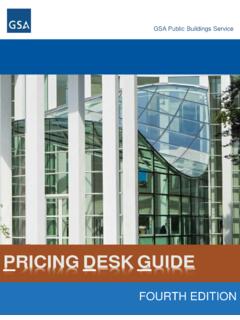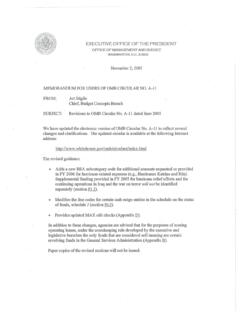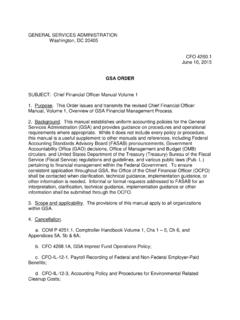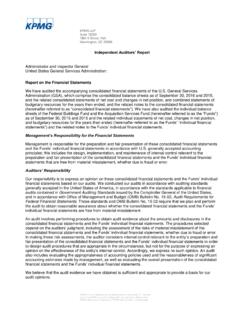Transcription of CIRCULATION: DEFINING AND PLANNING
1 INTRODUCTION ..4 NET AREA, circulation , & USABLE AREA CALCULATION METHODOLOGY circulation MULTIPLIER CONSIDERATIONSCASE STUDIES ..8 OVERVIEW CASE STUDIES 1-4 KEY TAKEAWAYS ..13 circulation : DEFINING AND PLANNINGMay 11, 2012 circulation : DEFINING and PlanningMay 11, 20121 Determining an organization s space needs typically begins by itemizing the various space types, their area, and quantity. The subtotal of this calculation, also known as Net Area, is then adjusted to take into account pathways leading to and in-between the different types of spaces. This is accomplished by applying a circulation Multiplier, which takes the form of 1.## ( , ), to the Net Area. The resulting subtotal becomes the total Usable Area for the organization and forms the starting point in the design and PLANNING for a new this seemingly straight forward approach, circulation Area is often under-estimated.
2 For decades, facility planners, designers, architects, and real estate professionals have adjusted the circulation Multiplier in order to achieve a target Usable Area, rather than reducing the space requirements for individual and support spaces. However, circulation is a necessary component of a space program. If the amount of area dedicated to circulation is underestimated, the programmed Usable Area may not reflect the amount needed to adequately accommodate the new : DEFINING and PLANNING is an attempt to bring clarity to this topic. It explores terminology, the difference between circulation Multipliers and circulation Factors, and a recommended method to estimate and plan for circulation . This document also explains, through the use of case study examples, how to evaluate a building s efficiency by calculating the actual circulation .
3 It s worth noting that the case studies and examples shown in this document are illustrated on full floor tenants, rather than multi-floor tenancy, for ease of explaining the concepts. They also use ANSI / BOMA , Standard Method for Measuring Floor Area in Office Buildings , as the basis for terminology definitions. circulation : DEFINING and PLANNING consists of four sections: DEFINING Adopting a common language about circulationPLANNING Determining how to use the right circulation Multiplier for a projectCASE STUDIES Demonstrating the impact of circulation in completed projectsKEY TAKEAWAYS Factors that should always be considered when calculating the circulation AreaINTRODUCTIONIf the amount of area dedicated to circulation is underestimated, the programmed Usable Area may not reflect the amount of space needed to accommodate the envisioned : DEFINING and PlanningMay 11, * Definitions per ANSI/BOMA - 1996, Standard Method for Measuring Floor Area in Office Buildings NET AREA (NET SQUARE FEET - NSF)The area of each identified program space .
4 For example, the Net Area of an 8 x 8 workstation is 64 NSF. It includes individual workspaces, dedicated and shared support spaces, and special mission-critical spaces. circulation AREA (PRIMARY & SECONDARY)Primary circulation is the main circulation route connecting to the building core and common spaces, such as elevators and exit stairs. Secondary circulation includes the aisles between individual spaces, such as offices and cubicles, and support AREA (USABLE SQUARE FEET - USF)*Area of a floor occupiable by a tenant where personnel or furniture are normally AREA (RENTABLE SQUARE FEET - RSF)*Total Usable Area plus a prorated allocation of the floor and building common areas within a building. GROSS AREA (GROSS SQUARE FEET - GSF)*Total area of a building enclosed by the exterior face of the perimeter walls, calculated on a floor-by-floor common language about office : DEFINING and PlanningMay 11, 20123 NET AREA (NSF) DEFINING * For additional details on these definitions and space calculation methods, please refer to ANSI/BOMA , Standard Method for Measuring Floor Area in Office Buildings.
5 What it IncludesHow it is MeasuredWhen is it AREA (USF)* AREA (RSF)* AREA (GSF)*Usable Area and building common spaces, such as the building lobbies, egress corridors, service spaces (mechanical/electrical, toilet, janitorial, etc), and loading docks. Excludes major vertical penetrations, such as stairwells, elevators, and major shaft exterior wall thickness, and all vertical penetrations (mechanical/electrical, plumbing, elevator shafts, stairwells, etc.), as well as basements, garages, and penthouses. Excludes parking lots and loading docks outside the building Net Area and circulation Area, but excludes building core and common spaces such as elevators, exit stairs, mechanical rooms, and core toilets. For multi-tenant floors, common building corridors are excluded from Usable Area and instead, are included in the Rental Area can be broken into two types: primary and secondary.
6 Primary circulation is the main route connecting the building core and common spaces, such as elevator lobbies, exit stairs, and core toilets. Secondary circulation is the aisles between individual and support workspaces (office and workstations), dedicated support (conference rooms, supply rooms, etc.), shared support (shared copier rooms, break rooms, etc), and special mission-critical support spaces (evidence rooms, laboratories, courtrooms, etc.)See ANSI/BOMA standard* for detailed calculation method. Generally speaking, measure the area enclosed between the finished surface of the office area side of corridors and the dominant portion of the exterior walls or vertical penetrations. PLANNING Formula: USF = NSF + circulation AreaBased on the ratio of enclosed spaces to open spaces, a circulation Multiplier is estimated and applied to the total Net Area to determine the circulation Area.
7 PLANNING Formula: circulation Area = NSF x ( circulation Multiplier - 1)See ANSI/BOMA standard* for detailed calculation method. Generally speaking, add the usable area to building common spaces while excluding major vertical penetrations. PLANNING Formula: RSF = USF + prorated share of Building Common AreaSee ANSI/BOMA standard* for detailed calculation method. Generally speaking, measure to the outside finished surface of permanent outer building walls. PLANNING Formula: GSF = RSF + Vertical Penetrations and Building Exterior WallsMeasure to the centerline of interior partitions of a space . Total Net Area is calculated by adding together all programmed areas. space Programming space Standards/Guidelines Tenant Improvements space Programming space Standards/Guidelines Tenant Improvements space Programming space Standards/Guidelines Tenant Improvements Commercial Leases Rent Calculation Construction Real Estate PortfolioA common language about office : DEFINING and PlanningMay 11, 20124 INDIVIDUAL WORKSPACE UNITSSUPPORT space UNITSQTY OF EACH UNITXNSF/UNITPLANNING.
8 NET AREA, circulation , & USABLE AREACIRCULATION MULTIPLIER (CM)TOTA L USABLE AREA (USF)TOTA L NET AREA (NSF)Storage/SupplyBreak RoomPrint/CopyGENERALOpen Meeting AreasConference RoomsCOLLABORATIONLabs, Courtrooms, Secure Evidence Storage, SPECIFICW orkstationsTouchdown StationsPrivate OfficesA circulation Multiplier is applied to the Net Area to estimate the amount of circulation Area that should be included in the Usable : DEFINING and PlanningMay 11, 5 FACTORPLANNING: CALCULATION METHODOLOGYCALCULATION METHODOLOGYCIRCULATION USF = circulation FACTOR (CF) 5 FACTORNSF CM = USF circulation AREA USF = CF28,000 x = 37,8009,800 37,800 = REQUIREMENT: 45,000 USFNSF + circulation AREA = USF NSF circulation AREA = circulation MULTIPLER (CM)28,000 + 17,000 = 45,00028,000 17,000 = ,000 45,000 = , a circulation Multiplier of applied to the Net Area was assumed to provide adequate space for circulation , regardless of the configuration of the building or the type and ratio of open and enclosed spaces.
9 However, when this method is used, the resultant circulation Area is just 26% of the total Usable Area. The following calculation illustrates this distinction using a total Net Area of 28,000 square feet and a circulation Multiplier (CM) of : circulation Area is a function of the open and enclosed spaces that exist in the workplace. When a floor plan is comprised of mostly open workstations, the circulation Area will typically be a greater portion of the total Usable Area than a plan made up of primarily enclosed office spaces. A unique circulation Multiplier should be chosen for each project after considering the anticipated proportion of open to enclosed spaces to be provided. Planners should avoid the practice of using the same circulation Multiplier on all workplace projects (see Common Misconception at right).
10 Care should also be taken to not confuse the circulation Multiplier with the circulation Factor. The circulation Multiplier is applied to Net Area. The circulation Factor is the percentage of Usable Area that makes up the circulation Area. This distinction is demonstrated below:COMMON MISCONCEPTIONCIRCULATION AREA = ~ 17,000 NSFL egendThe proportion of open to enclosed spaces is the best gauge for determining a circulation + SUPPORT = ~ 28,000 NSFL egendAs subsequent case studies will illustrate, this circulation Multiplier can be appropriate when the total Net Area is primarily composed of enclosed spaces, such as private offices. In open workplace settings however, a circulation Multiplier of will often be - NSF = circulation AREA37,800 - 28,000 = 9,800 circulation : DEFINING and PlanningMay 11, 20126 PLANNING : circulation MULTIPLIER CONSIDERATIONSLARGE ENCLOSED SUPPORT AND SPECIAL SPACESIf an organization s program includes large support spaces ( , training rooms, storage) or special mission-critical spaces ( , courtrooms, law libraries), the requirement for circulation Area may be reduced.











